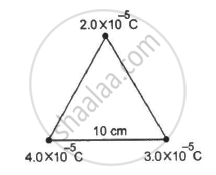Advertisements
Advertisements
Question
Suppose all the electrons of 100 g water are lumped together to form a negatively-charged particle and all the nuclei are lumped together to form a positively-charged particle. If these two particles are placed 10.0 cm away from each other, find the force of attraction between them. Compare it with your weight.
Solution
Molecular mass of water= 18 g
So, number of atoms in 18 g of H2O = Avogadro's number
= 6.023 × 1023
Number of electrons in 1 atom of H2O = (2 × 1) + 8 = 10
Number of electrons in 6.023 × 1023 atoms of H2O = 6.023 × 1024
That is, number of electrons in 18 g of H2O = 6.023 × 1024
So, number of electrons in 100 g of H2O = \[\frac{6 . 023 \times {10}^{24}}{18} \times 100\]
= 3.34 × 1025
Total charge = 3.34 × 1025 × (−1.6 × 10−19)
= − 5.34 × 106 C
So total charge of electrons in 100 gm of water, q1 = −5.34 × 106 C
Similarly, total charge of protons in 100 gm of water, q2 = +5.34 × 106 C
Given, r = 10 cm = 0.1 m
By Coulomb's Law, electrostatic force,
\[= 9 \times {10}^9 \times \frac{5 . 34 \times {10}^6 \times 5 . 34 \times {10}^6}{{10}^{- 2}}\]
\[ = 2 . 56 \times {10}^{25} N\]
This force will be attractive in nature.
Result shows that the electrostatic force is much stronger than the gravitational force between any us and earth( weight = gravitational force between us and earth ).
APPEARS IN
RELATED QUESTIONS
The electrostatic force on a small sphere of charge 0.4 μC due to another small sphere of charge − 0.8 μC in air is 0.2 N.
- What is the distance between the two spheres?
- What is the force on the second sphere due to the first?
Check that the ratio ke2/G memp is dimensionless. Look up a Table of Physical Constants and determine the value of this ratio. What does the ratio signify?
Three-point charges q, – 4q and 2q are placed at the vertices of an equilateral triangle ABC of side 'l' as shown in the figure. Obtain the expression for the magnitude of the resultant electric force acting on the charge q

(b) Find out the amount of the work done to separate the charges at infinite distance.
Write any two important points of similarities and differences each between Coulomb's law for the electrostatic field and Biot-Savart's law of the magnetic field ?
Plot a graph showing the variation of coulomb force (F) versus ,`(1/r^2)` where r is the distance between the two charges of each pair of charges: (1 μC, 2 μC) and (2 μC, − 3 μC). Interpret the graphs obtained.
Find the electric force between two protons separated by a distance of 1 fermi (1 fermi = 10−15 m). The protons in a nucleus remain at a separation of this order.
Four equal charges of 2.0 × 10−6 C each are fixed at the four corners of a square of side 5 cm. Find the Coulomb's force experienced by one of the charges due to the other three.
Two equal charges, 2.0 × 10−7 C each, are held fixed at a separation of 20 cm. A third charge of equal magnitude is placed midway between the two charges. It is now moved to a point 20 cm from both the charges. How much work is done by the electric field during the process?
How much work has to be done in assembling three charged particles at the vertices of an equilateral triangle, as shown in the figure?
Answer the following question.
What is relative permittivity?
Write a short note on superposition principle.
Three charges +Q, q, +Q are placed respectively, at distance, 0, d/2 and d from the origin, on the X-axis. If the net force experienced by +Q, placed at x = 0, is zero then value of q is ____________.
The electric force acting between two point charges kept at a certain distance in vacuum is 16 N. If the same two charges are kept at the same distance in a medium of dielectric constant 8, the electric force acting between them is ____________ N.
Polarised dielectric is equivalent to ______.
For charges q1 and q2 separated by a distance R the magnitude of the electrostatic force is given by ______.
A spring of spring constant 5 × 103 N/m is stretched initially by 5 cm from the unstretched position. Then the work required to stretch it further by another 5 cm is:
The S.I unit of electric permittivity is
Electric charge of any system is ______.
Two point charges +2 C and +6 C repel each other with a force of 12 N. If a charge of -4 C is given to each of these charges, then the force now is ______.
